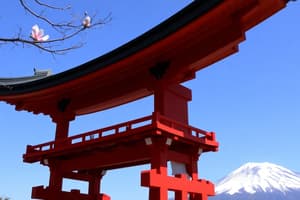Podcast
Questions and Answers
What was the traditional use of the chrysanthemum by Japanese samurai and shoguns?
What was the traditional use of the chrysanthemum by Japanese samurai and shoguns?
- As a decoration on their armor
- As a symbol of their military rank
- As a personal seal and signature on documents (correct)
- As an offering to the gods
Who established the chrysanthemum as the imperial monogram in Japan?
Who established the chrysanthemum as the imperial monogram in Japan?
- Emperor Hirohito
- Emperor Sutoku
- Emperor Meiji
- Emperor Genji (correct)
What change did Emperor Meiji make regarding the use of the chrysanthemum?
What change did Emperor Meiji make regarding the use of the chrysanthemum?
- He made the chrysanthemum the exclusive symbol of the imperial family
- He introduced the chrysanthemum as the new imperial seal
- He retained the use of the chrysanthemum as the monarch's crest (correct)
- He abolished the use of the chrysanthemum as the imperial monogram
Which of the following companies is NOT mentioned in the text as currently using the chrysanthemum?
Which of the following companies is NOT mentioned in the text as currently using the chrysanthemum?
What is the significance of the chrysanthemum being used as the monarch's crest in Japan?
What is the significance of the chrysanthemum being used as the monarch's crest in Japan?
Which of the following is NOT considered one of the auspicious flowers brought by Princess Yamato Hime from heaven?
Which of the following is NOT considered one of the auspicious flowers brought by Princess Yamato Hime from heaven?
What is a common modern use of the chrysanthemum emblem in Japan?
What is a common modern use of the chrysanthemum emblem in Japan?
Which of the following statements about the chrysanthemum is NOT true?
Which of the following statements about the chrysanthemum is NOT true?
Which of the following regions in Japan is specifically mentioned as using the chrysanthemum emblem?
Which of the following regions in Japan is specifically mentioned as using the chrysanthemum emblem?
What makes the chrysanthemum a popular subject for paintings and photographs?
What makes the chrysanthemum a popular subject for paintings and photographs?
Flashcards are hidden until you start studying
Study Notes
The Sign of the Chrysanthemum
The chrysanthemum was traditionally used by Japanese samurai and shoguns as a personal seal, known as a Kizuka, which also served as their signature on documents. It is still used today by some Japanese politicians and organizations. Here is what you need to know about this emblematic flower.
History of the Chrysanthemum
As per Suehiro's book, A Guide to Japanese Culture, an emperor named Genji (Emperor Sutoku, 8th Century Japan) established the chrysanthemum as his monogram when he signed governmental papers. From Genji down through the centuries, every emperor adopted it for himself. This practice continued until Emperor Meiji in the late 19th century, who abolished the old system of sigils associated with each reign period from 1 to 16. He did so because the numbering system, called Jōjōkei, had become obsolete due to changes in the imperial family during the preceding two centuries. However, one exception was made for the chrysanthemum, which has remained the monarch's crest ever since.
The link to the article can be found here here for further reading.
Usage Today
Nowadays, the chrysanthemum is mostly used by companies operating within the Kyushu region of Japan, such as Mitsubishi Heavy Industries Ltd., Nippon Steel Corp., Fujikura Co. Ltd., and Sharp Corporation. In addition, many universities in this area also carry the chrysanthemum sign in their logos, including Fukuoka University and Nagasaki University. Hospitals in Kyushu often have the chrysanthemum symbol displayed outside their entrances. Furthermore, Yokohama City and Kumamoto Prefecture both have the chrysanthemum as their official symbols.
Symbolism
In Japan, the chrysanthemum is considered the most auspicious flower. While it is native to East Asia and the Pacific Islands, it is now widely cultivated around the world and is prized for its beauty and resilience. The chrysanthemum's multiple layers of petals and vibrant colors make it a popular subject for paintings and photographs. According to legend, a divine deity named Amaterasu sent her granddaughter, Princess Yamato Hime, from heaven to rule over Japan. Upon arrival, she carried a bouquet of flowers, among them were cherry blossoms, maple leaves, peony blossoms, and five kinds of chrysanthemums. Over time, these flowers became deeply ingrained in Japanese culture, particularly the chrysanthemum.
Modern Uses
In modern times, the use of the chrysanthemum emblem in Japan has been revived, with many hotels, restaurants, and other establishments displaying it as a sign of their Japanese heritage. For example, the Hakone Sekisho Inn in Hakone displays the chrysanthemum on its sign, along with the words "Hakone Sekisho Inn" in Japanese. This revival of the chrysanthemum emblem is a testament to its historical significance and cultural importance in Japan.
In conclusion, the chrysanthemum is a flower with deep historical and cultural significance in Japan. Once used as a personal seal by samurai and shoguns, it is now mostly used by companies, universities, and government entities in the Kyushu region of Japan. The chrysanthemum's beauty and resilience have made it a popular subject for art and an enduring symbol of Japanese heritage.
Studying That Suits You
Use AI to generate personalized quizzes and flashcards to suit your learning preferences.





